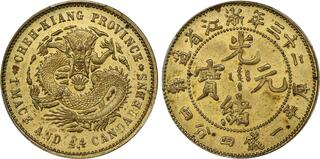| Stack's Bowers Galleries (& Ponterio) > April 2024 Hong Kong Auction | Auction date: 15 April 2024 |
| Lot number: 40005 Price realized: Unsold | Show similar lots on CoinArchives Find similar lots in upcoming auctions on |
| Lot description: (t) CHINA. Chekiang. Brass 1 Mace 4.4 Candareens (20 Cents) Pattern, Year 23 (1897). Esslingen (Otto Beh) Mint. Kuang-hsu (Guangxu). PCGS SPECIMEN-63+. cf. L&M-273 (silver pattern); cf. K-117 (same); cf. KM-53.5 (same); cf. WS-1012C (same). Sporting a brassy-olive hue and an alluring, crisply struck look, this charming specimen undoubtedly holds a place among the pantheon of issues from the early years of the vintage Chinese series. Issued as an off-metal pattern striking in brass, it shares similarities with other pattern issues in brass and aluminum from provinces such as Anhwei and Fengtien. However, such trials for Chekiang are that much RARER and seemingly never encountered in the marketplace. Indeed, while one can locate a few disparate records of the latter provincial off-metal trial strikings, those for Chekiang remain the most elusive. The only such example that this cataloger could locate is a Brass "3.2 Candareens" error denomination (graded NGC MS-63), realizing a hammer of $24,000 when it sold as part of the Norman Jacobs Collection in August 2008 (there listed as "extremely rare, possibly unique"). As such, the importance of this piece cannot be overstated, and it should no doubt present much in the way of spirited bidding and fanfare when it ultimately joins its new, highly deserving cabinet. The recent discovery of production material has shone new light on the creation of this coinage. Such findings included patterns, dies, hubs and a series of punches from the archives of the Otto Beh company in Esslingen, Germany. Before this, the origin of the dies used to produce coinage for the provinces of Anhwei, Chekiang, Fengtien, Heilungkiang and Sungarei was only speculated upon. Otto Beh was a specialist in the production of seals and dies. From neighboring Goppingen, Louis Schuler received an order for coining presses in 1895 and commissioned Otto Beh to manufacture the dies. In 1897 and 1898, Beh supplied Schuler with over 200 dies for Chinese coins. At the time, this was the largest order that the company had ever received. Schuler, which started as a Locksmith's shop in 1839, had grown to become one of the world's leaders in metal forming and, in fact, supplied the aforementioned mints with coining presses. Estimate: $100000 - $200000 |  |



